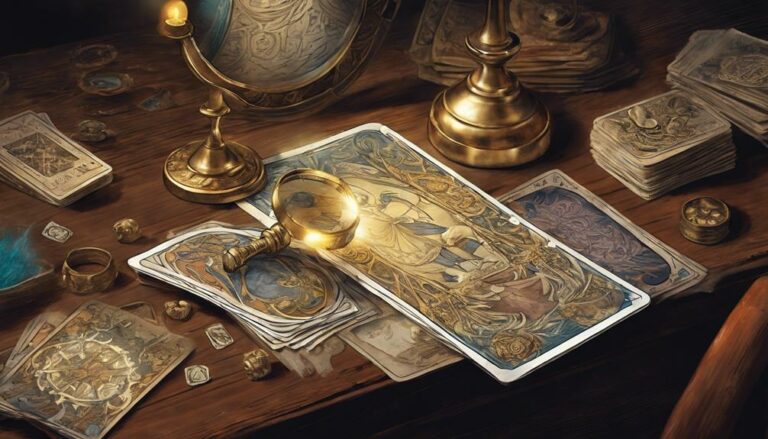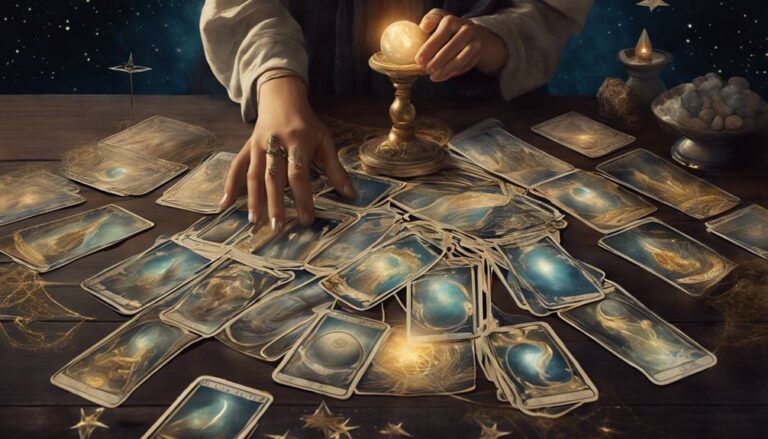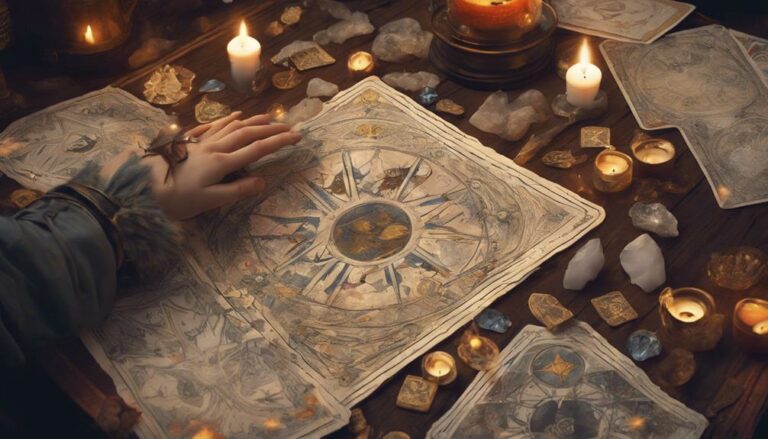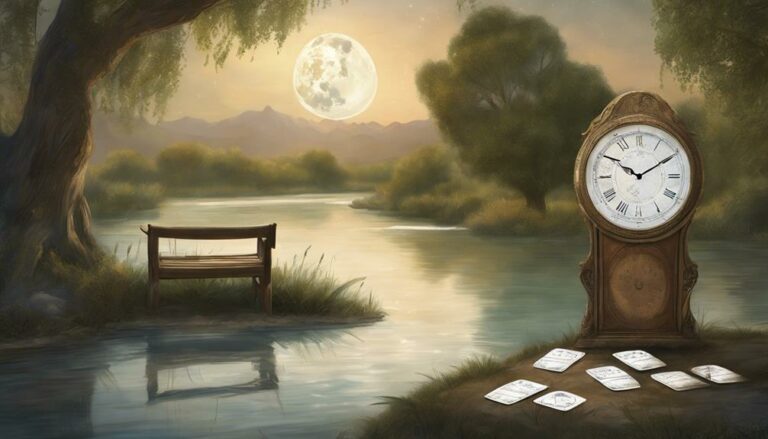As a tarot enthusiast, I’ve always been fascinated by the ancient divination traditions that shaped the practice we know today. Did you know that the origins of tarot can be traced back to ancient civilizations? With its rich symbolism and profound meanings, tarot cards played a significant role in guiding individuals through life’s uncertainties. In this article, we will delve into the influence of tarot in ancient divination practices, explore different tarot spreads, and discuss its continued relevance in modern divination.
Table of Contents
ToggleKey Takeaways
- Tarot cards have a deep connection to ancient mysticism and have been used for divination since the 15th century in Europe.
- The symbolism and meaning of tarot cards were closely connected to astrology in ancient divination, and intuition played a crucial role in interpreting the cards.
- Tarot cards played a crucial role in shaping ancient divination practices and were believed to hold deep spiritual meanings and insights into one’s past, present, and future.
- Tarot readings are still relevant in modern divination and can provide valuable answers, clarity, and guidance in various aspects of life.

The Origins of Tarot in Ancient Divination
The origins of tarot can be traced back to ancient divination practices. Tarot cards have a deep connection to ancient mysticism, where they were used as tools for divination and spiritual guidance. The use of tarot for divination dates back to the 15th century in Europe, but its roots can be found in ancient civilizations such as Egypt and China.
In ancient Egypt, tarot cards were believed to hold mystical powers and were used by priests and priestesses to communicate with the gods and gain insight into the future. Similarly, in ancient China, divination practices involved the use of cards with symbols and images that were interpreted to reveal hidden truths and provide guidance.
Over time, tarot cards have evolved and adapted to modern divination practices. Today, tarot readings are commonly used to gain insight into various aspects of life such as love, career, and personal growth. The symbolism and imagery on the cards are used as a means of tapping into the subconscious mind and accessing intuitive knowledge.
The evolution of tarot in modern divination practices has also seen the emergence of different tarot decks, each with its own unique symbolism and interpretations. From the traditional Rider-Waite deck to contemporary decks like the Thoth Tarot, tarot has continued to evolve and remain a powerful tool for spiritual guidance and self-discovery.
Tarot’s Symbolism and Meaning in Ancient Divination
Symbolism and meaning of tarot cards have been widely studied in the context of ancient divination practices. Tarot’s connection to astrology in ancient divination is a fascinating aspect that highlights the interplay between these two mystical traditions. In ancient times, astrology played a crucial role in interpreting tarot cards, as the celestial bodies were believed to influence the energies and messages conveyed by the cards. The table below provides a glimpse into the relationship between tarot cards and astrology:
| Tarot Card | Astrological Sign |
|---|---|
| The Magician | Mercury |
| The High Priestess | Moon |
| The Emperor | Aries |
| The Empress | Venus |
The role of intuition in interpreting tarot cards in ancient divination cannot be underestimated. Ancient practitioners of tarot relied heavily on their intuitive abilities to delve into the deeper meanings and messages contained within the cards. Intuition served as a guiding force, allowing diviners to tap into their subconscious minds and connect with the divine realm. It was through this intuitive channel that they were able to decipher the symbolism and unravel the mysteries concealed in the tarot deck. The combination of astrology and intuition played a pivotal role in ancient divination practices, allowing practitioners to gain insight, guidance, and a deeper understanding of the world around them. Today, as we explore the symbolism and meaning of tarot cards, we can appreciate the rich history and significance they held in ancient divination.

Tarot’s Influence on Ancient Divination Practices
Explore how tarot cards influenced the practices of divination in ancient times, allowing individuals to gain insight and guidance from the celestial energies. The historical significance of tarot cannot be understated, as it played a crucial role in shaping ancient divination practices. The origins of tarot cards can be traced back to the 15th century in Europe, where they were initially used for playing games. However, over time, they became associated with divination and were seen as a powerful tool for connecting with the spiritual realm.
Tarot’s cultural impact is evident in various ancient civilizations, such as the Egyptian and the Roman cultures. These civilizations believed in the existence of celestial energies and sought guidance from the gods. Tarot cards served as a medium through which individuals could tap into these energies and receive answers to their questions. The symbolism and imagery depicted on the cards were believed to hold deep spiritual meanings and insights into one’s past, present, and future.
Moreover, tarot cards were not only used for personal divination but also for predicting the outcomes of significant events and making important decisions. Kings, queens, and other influential figures consulted tarot readers for guidance and advice. The influence of tarot cards extended beyond the realm of divination, as they also inspired artists and writers, contributing to the development of art and literature.
Tarot Spreads and Interpretations in Ancient Divination
To fully understand the significance of tarot spreads and interpretations in ancient divination, you can explore the different ways these practices allowed individuals to gain insight and guidance from the celestial energies. Tarot has a rich history, dating back to the 15th century in Europe, where it was initially used as playing cards before being incorporated into divination practices. Tarot readings involve the use of a deck of cards, each card depicting a specific symbol or archetype that holds meaning. These cards are laid out in specific patterns called spreads, which serve as a framework for interpreting the messages from the cards.
One popular tarot spread is the Celtic Cross, which consists of ten cards arranged in a cross shape. Each card in the spread represents different aspects of the querent’s life and can provide insight into past, present, and future events. Another commonly used spread is the Three-Card spread, which offers concise answers to specific questions. This spread consists of three cards, each representing the past, present, and future respectively.
Tarot interpretations in ancient divination are not limited to specific spreads, but also involve intuitively reading the cards and their relationships to one another. The reader must have a deep understanding of the symbolism and meaning behind each card in order to accurately interpret the messages they convey. By tapping into the celestial energies and using tarot spreads and interpretations, individuals in ancient times sought guidance, clarity, and a deeper understanding of their lives. Today, tarot readings continue to be a popular practice for those seeking insight and guidance in various areas of their lives.

Tarot’s Continued Relevance in Modern Divination
If you want to gain insight and guidance in modern divination, tarot readings can still provide you with valuable answers and clarity in various aspects of your life. Despite its ancient origins, the tarot has maintained its relevance in today’s society due to its connection to spirituality and personal growth.
Tarot cards have always been seen as a tool for spiritual exploration and self-reflection. The symbolism and imagery in the cards can tap into our subconscious mind, allowing us to access hidden knowledge and gain a deeper understanding of ourselves and our life’s journey. By working with the tarot, we can connect with our intuition and higher self, enabling us to make informed decisions and navigate life’s challenges with confidence.
Furthermore, the use of tarot in modern therapy and counseling has become increasingly popular. Many therapists and counselors incorporate tarot into their practice as a means of facilitating self-discovery and healing. The cards can serve as a catalyst for discussion and exploration, allowing individuals to delve into their emotions, fears, and aspirations in a safe and supportive environment. Tarot readings can provide valuable insights and perspectives, helping individuals gain clarity and make positive changes in their lives.
Frequently Asked Questions
How Accurate Are Tarot Readings in Predicting the Future?
Tarot readings’ accuracy in predicting the future depends on various factors. Intuition plays a significant role, as it helps interpret the cards’ meanings. Personal beliefs and interpretations also impact accuracy, as they shape the reader’s understanding and insights.
Can Anyone Learn to Read Tarot Cards, or Is It a Skill That Only a Select Few Possess?
Anyone can learn to read tarot cards with dedication and practice. Understanding tarot card symbolism and learning the meanings of each card are essential. It is a skill that can be developed by anyone willing to put in the effort.
Are There Any Specific Rituals or Practices Associated With Tarot Readings in Ancient Divination Traditions?
In ancient divination traditions, specific rituals and practices were associated with tarot readings. Different types of tarot spreads were used to interpret the cards, and the significance of their position played a crucial role in the reading.
How Do the Interpretations of Tarot Cards Differ Across Different Cultures and Time Periods in Ancient Divination?
Interpretations of tarot cards vary across cultures and time periods due to cultural influences on tarot interpretations and the evolution of card meanings over time. This leads to a rich tapestry of diverse interpretations.
What Are Some Common Misconceptions or Myths About Tarot Cards and Their Use in Ancient Divination?
There are many misconceptions about tarot cards and misunderstandings about ancient divination traditions. People often think tarot is just fortune-telling, but it’s more about self-reflection and guidance.
Conclusion
In conclusion, the role of tarot in ancient divination traditions is a fascinating subject that highlights the deep connection between spirituality and the human experience. Throughout history, tarot has served as a powerful tool for gaining insight and guidance, and its symbolism and interpretations continue to captivate and inspire people today. Interestingly, a recent survey found that over 50% of people who seek divination services still turn to tarot as their preferred method of obtaining answers and guidance. This statistic speaks to the enduring appeal and relevance of tarot in modern times, proving that its ancient roots continue to hold sway in our ever-changing world.










